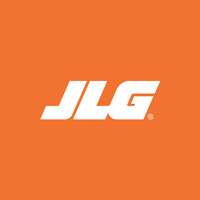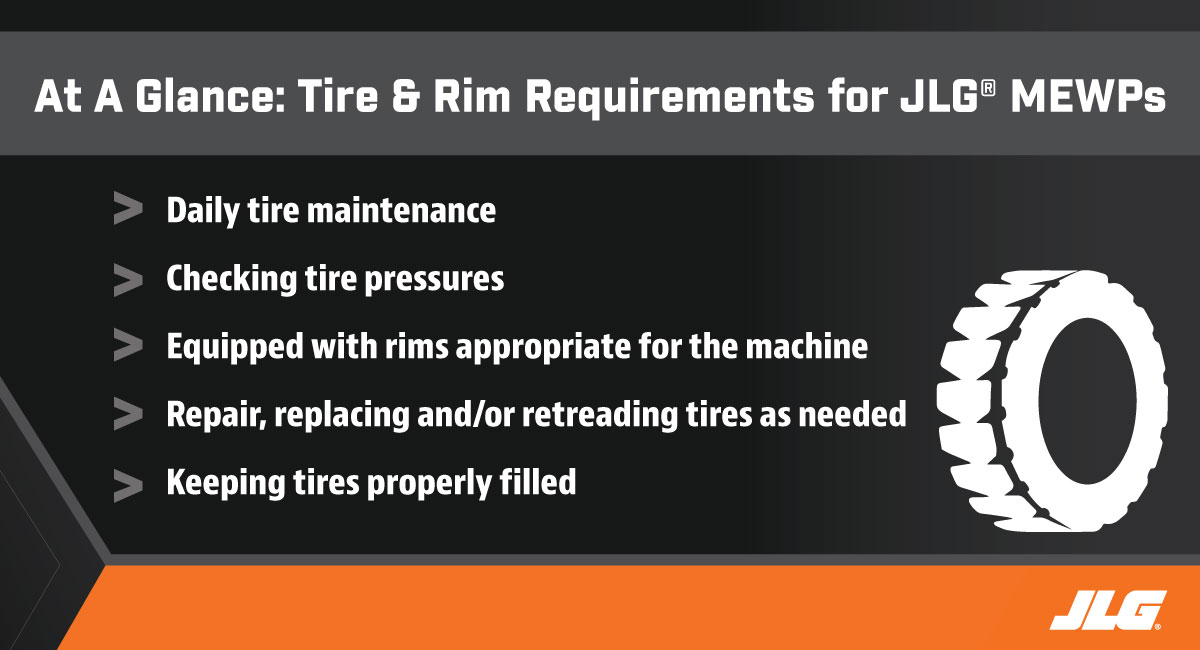 Mark Vaughns
Mark Vaughns
Director of Product Safety & Reliability
____
JLG Industries
Tires play a big role in the performance and productivity of mobile elevating work platforms (MEWPs) — influencing both the terrainability (aka rideability) of the machine, as well as its stability.
For example, a tire that is too hard (or too soft) will affect the way the machine contacts the ground, as well as its balance. When carrying people and materials to height, these factors are extremely important to the safe use of the machine.
Because tires are such a significant part of a MEWP, the pneumatic or foam-filled tire assemblies installed on JLG® MEWPs have been approved by JLG and the tire manufacturer for applications in which the products are intended to be used.
When it comes to following best practices for the safe operation of MEWPs, preventive tire care is a must. Below are safety recommendations and requirements to follow when caring for the tires on your JLG MEWP.

Tire Maintenance
The tires and rims installed on JLG products need to be inspected daily as part of the daily machine walk-around inspection. This inspection includes foam-filled tire assemblies, as well as pneumatic tires.
JLG recommends that the daily walk-around inspection be performed at each operator change during a shift and at each shift change.
Tire Pressures
The tire pressures that are labeled on the side of the JLG product, or the rim, are approved by the tire manufacturer. These pressures may be higher than that stated on the tire in order to achieve stiffness of the tire sidewall for stability purposes. The maximum load carrying capacity and inflation pressure, as specified on the tire sidewall, are ratings* for a specific type of application and are indicative of the ability of the tire to dissipate heat.
*Due to the slow speed application of our equipment, we can exceed these ratings in accordance with specifications, which are determined by the tire manufacturer and the Tire and Rim Association.
The air pressure for pneumatic tires must be equal to the air pressure that is stenciled on the side of the JLG product or rim decal for safe and proper operational characteristics.
Rims
The rims installed on each JLG MEWP product model have been designed for stability requirements which consist of track width, tire pressure and load capacity.
Please note that size changes, such as rim width, centerpiece location, larger or smaller diameter, etc., without written factory recommendations, may result in an unsafe condition regarding stability.
Repair
For pneumatic tires, JLG recommends that when any cut, rip or tear is discovered that exposes sidewall or tread area cords in the tire, measures must be taken to remove the JLG product from service immediately. Arrangements must be made for replacement of the tire or tire assembly.
For polyurethane foam-filled tires, JLG recommends that when any of the following are discovered, measures must be taken to remove the JLG product from service immediately and arrangements must be made for replacement of the tire or tire assembly:
- Smooth, even cut through the cord plies which exceeds 3 inches in total length;
- Tears or rips (ragged edges) in the cord plies which exceeds 1 inch in any direction;
- Punctures which exceed 1 inch in diameter; or
- Damage to the bead area cords of the tire;
- Evidence of fluid leaving the tire at the valve stem, bead of the tire or at any punctures/holes in the tire;
- For tires that appear to have “flat spotting” at the interface to the ground, insert a 2-3 mm diameter wire into the hole opposite the valve stem (tread area of tire), remove the wire and if there is wet or oily residue on the wire, the polyurethan foam is not fully cured.
If a tire is damaged, but is within the above noted criteria, the tire must be inspected on a daily basis to ensure the damage has not propagated beyond the allowable criteria.
Tubes may be installed inside of tires that meet the criteria outlined above for useable tires, only to eliminate small air leaks (i.e., bead leaks, small nail puncture, etc.).
Radial nail hole repairs up to 3/8-inch diameter may be made by using an industry-approved commercial/industrial tire repair procedure, such as an internally applied plug and liner patch repair system, provided the nail hole is at least one inch inside the shoulder.
Do not attempt any section repairs or repairs to the shoulder or sidewall areas.
Replacement
JLG recommends that any replacement tire be the same size, ply and brand as originally installed on the machine. Please refer to the JLG Parts Manual for the part number of the approved tires for a particular machine model.
If not using a JLG approved replacement tire, we recommend that replacement tires have the following characteristics:
- Equal or greater ply/load rating and size of original;
- Tire tread contact width equal or greater than original;
- Wheel diameter, width, and offset dimensions equal to original; and
- Approved for the application by the tire manufacturer (including inflation pressure and maximum tire load)
Unless specifically approved by JLG, do not replace a foam filled tire assembly with a pneumatic tire.
When selecting and installing a replacement tire, you need to ensure that all tires are inflated to the pressure recommended by JLG.
Due to size variations between tire brands, both tires on the same axle should be the same and all four tires should contain the same fill media.
Retreading
The retreading of original tires used on JLG products voids the original tire warranty. JLG is not responsible for the quality, utilization or application of retreaded tires.
The retreading of original tires is authorized only when the following conditions can be met:
- Original tire casing is in serviceable condition, with no cuts or damage that exposes sidewall cords or damage to tread area cords;
- The tire has no previous repairs;
- The replacement tread contact width is equal to or greater than original;
- The re-treaded tire diameter is within the accepted tolerances for the original tire diameter as stated by The Tire and Rim Association Inc;
- The re-treaded tire is approved for the application by the tire re-treading supplier (including inflation pressure and maximum tire load); and
- The re-treading process follows the Tire Retread Information Bureau or equivalent guidelines.
Tire Fill
All JLG MEWPs* equipped with pneumatic tires may be foam filled. JLG recommends using a high-quality polyurethane foam tire fill with a minimum durometer of 28“A” (ASTM D2240 specification) for most tires. The 445/50-D710 tire on the 1500AJP and 1850SJP boom lifts, require the use of a heavy-duty tire fill with a minimum durometer of 45 “A” (ASTM D2240 specification).
It is important to note: The tire must be filled at the same air pressure as recommended for a pneumatic application. All applicable procedures must be followed as improperly installed tire fill may cause unsatisfactory machine performance.
*Telehandlers, which are classified by OSHA as Class 7 forklifts, not MEWPs, follow much of this same tire guidance. The following JLG telehandler models are not equipped with, nor approved to use, foam-filled tires: G5-19A; G6-23A; 266; and 307.
The owner(s) and user(s) of the JLG MEWP are responsible for the structural integrity and selection of tires and rims. Please note: JLG assumes no liability for claims arising from misuse of the product. More guidance on safety requirements for tire and rim requirements on JLG MEWPs is available here.
Want to stay up to date with industry news and trends similar to this? Make sure you subscribe below to receive monthly updates from Direct Access with newly posted content so you never miss important information.